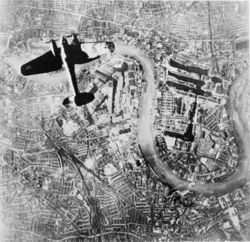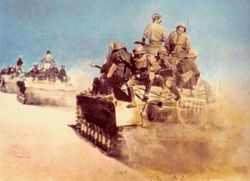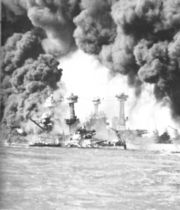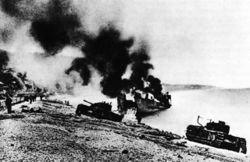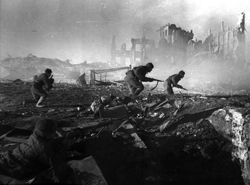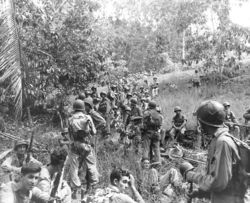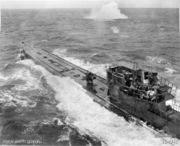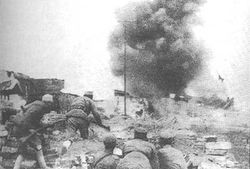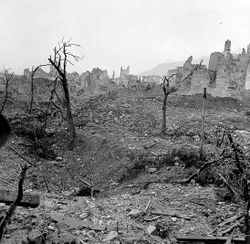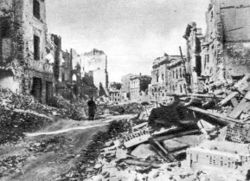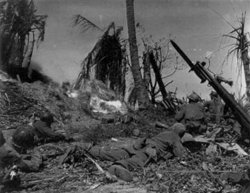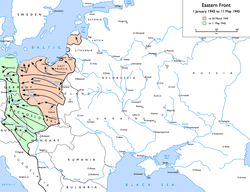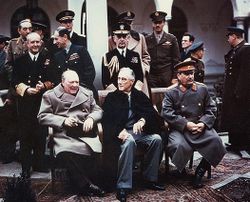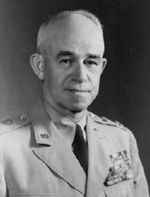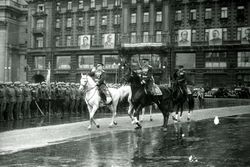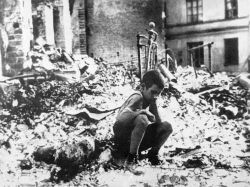World War II
2007 Schools Wikipedia Selection. Related subjects: British History Post 1900
| World War II | |||||||
|---|---|---|---|---|---|---|---|
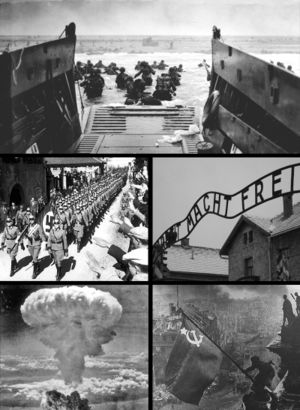 Clockwise from top: Allied landing on Normandy beaches on D-Day, the gate of a Nazi concentration camp at Auschwitz, Red Army soldiers raising the Soviet flag over the Reichstag in Berlin, the Nagasaki atom bomb, and the 1936 Nuremberg Rally. |
|||||||
|
|||||||
| Combatants | |||||||
| Allied powers: and others |
Axis powers: and others |
||||||
| Commanders | |||||||
| Casualties | |||||||
| Military dead: 17,000,000 Civilian dead: 33,000,000 Total dead: 50,000,000 |
Military dead: 8,000,000 Civilian dead: 4,000,000 Total dead: 12,000,000 |
||||||
| Theatres of World War II |
|---|
| Europe – Eastern Europe – Africa – Middle East – Mediterranean – Asia & Pacific – Atlantic |
World War II, or the Second World War, was a worldwide conflict fought between the Allied Powers and the Axis Powers, from 1939 until 1945. Armed forces from over seventy nations engaged in aerial, naval, and ground-based combat. Spanning much of the globe, World War II resulted in the deaths of over sixty million people, making it the deadliest conflict in human history. The war ended in 1945 with an Allied victory.
Overview
Europe
On September 1, 1939, Germany, led by Adolf Hitler and the Nazi Party, invaded Poland according to an agreement with the Soviet Union, which joined the invasion on September 17. The United Kingdom and France responded by declaring war on Germany on September 3, initiating a widespread naval war. Germany rapidly overwhelmed Poland, then Norway, the Netherlands, Belgium and France in 1940, and Yugoslavia and Greece in 1941. Italian, and later German, troops attacked British forces in North Africa. By summer 1941, Germany had conquered France and most of Western Europe, but it had failed to subdue the United Kingdom due to the success of the Royal Air Force and Royal Navy.
Hitler then turned on the Soviet Union, opening a surprise attack (Codename: Barbarossa) on June 22, 1941. Despite enormous gains, the invasion bogged down outside of Moscow in late 1941. The Soviets later encircled and captured the German Sixth Army at the Battle of Stalingrad (1942-43), decisively defeated the Axis during the Battle of Kursk, and broke the Siege of Leningrad. The Red Army then pursued the retreating Wehrmacht all the way to Berlin, and won the street-by-street Battle of Berlin, as Hitler committed suicide in his underground bunker on April 30, 1945.
Meanwhile, the western Allies invaded Italy (1943) and then liberated France in 1944, following amphibious landings in the Battle of Normandy. Repulsing a German counterattack at the Battle of the Bulge in December, the Allies crossed the Rhine River and linked up with the Soviets at the Elbe River in central Germany.
During the war, six million Jews, as well as Roma and other groups, were murdered by Germany in a state-sponsored genocide known as The Holocaust.
Asia and the Pacific
Japan invaded China on July 7, 1937 (see Second Sino-Japanese war) with plans to expand to most of East and South-East Asia. On December 7, 1941 Japan launched surprise attacks against several countries, including the major United States Navy base at Pearl Harbour, thereby drawing the United States into the war.
After six months of sweeping successes, the Japanese were checked at the Battle of the Coral Sea and decisively defeated in the Battle of Midway, in which they lost four aircraft carriers. Japanese expansion was finally stopped and the Allies went on the offensive at the Battle of Milne Bay and the Battle of Guadalcanal, both in the Southwest Pacific. The Allies then conducted a drive across the Central Pacific, and were victorious in a series of great naval battles such as the Battle of the Philippine Sea and the Battle of Leyte Gulf in 1944, and invasions of key islands such as Iwo Jima and Okinawa in 1945. In the meantime, American submarines gradually cut off the supply of oil and other raw materials to Japan.
In the last year of the war Allied air forces conducted a strategic firebombing campaign against the Japanese homeland. On August 6, 1945, the U.S. dropped an atomic bomb on the Japanese city of Hiroshima, and on August 9 another was dropped on Nagasaki. Japan surrendered on August 15, 1945.
Aftermath
About 62 million people, or 2.5% of the world population, died in the war, though estimates vary greatly (refer to the Casualties section). Large swaths of Europe and Asia were devastated and took years to recover. The war had political and technological consequences that last to this day.
Causes
The immediate Causes of World War II are generally held to be the German invasion of Poland, and the Japanese attacks on China, the United States, and the British and Dutch colonies. In each of these cases, the attacks were the result of a decision made by authoritarian ruling elites in Germany and Japan. World War II started after these aggressive actions were met with an official declaration of war, armed resistance or both.
The Nazi Party came to power in Germany by democratic means, although after acquiring power they eliminated most vestiges of Germany's democratic system. The reasons for their popularity included their renouncement of the Treaty of Versailles (particularly Article 231, known as the "Guilt Clause"), which had placed many restrictions on Germany since the end of the World War I, staunch anti-communism, the Dolchstosslegende and promises of stability and economic reconstruction. They also appealed to a sense of Germanic identity, superiority and entitlement, which would play an important role in starting the war, as they demanded the integration of lands they considered to be rightfully belonging to Germany. Hitler was also portrayed by himself, his party, and his book Mein Kampf as an almost otherworldly savior for the German people.
Imperial Japan in the 1930s was largely ruled by a militarist clique of Army and Navy leaders, devoted to Japan becoming a world colonial power. Japan invaded Manchuria in 1931 and China in 1937 to bolster its meager stock of natural resources and extend its colonial control over a wider area. The United States and the United Kingdom reacted by making loans to China, providing covert military assistance, pilots and fighter aircraft to Kuomintang China and instituting increasingly broad embargoes of raw materials and oil against Japan. These embargoes would potentially have eventually forced Japan to give up its newly conquered possessions in China or find new sources of oil and other materials to run their economy. Japan was faced with the choice of withdrawing from China, negotiating some compromise, developing new sources of supply, buying what they needed some where else, or going to war to conquer the territories that contained oil, bauxite and other resources in the Dutch East Indies, Malay and the Philippines. Believing the French, Dutch and British governments more than occupied with the war in Europe, the Soviets reeling from German attacks and that the United States could not be organized for war for years and would seek a compromise before waging full scale war, they chose the latter, and went ahead with plans for the Greater East Asia War in the Pacific.
The direct cause of the United States' entry into the war with Japan was the attack on Pearl Harbour on December 7, 1941. Germany declared war on the United States on December 12, 1941.
Chronology
War breaks out: 1939
European Theatre
German policy aims and ideologies
The chief stated aim of the German policy at the time was the reacquisition of German territories taken by the Treaty of Versailles, and the addition of ethnic German regions of former Austria-Hungary to form a Greater Germany.
Hitler's real agenda was clearly the takeover of neighboring countries. In fact, when he annexed Czechoslovakia in the previous year, without any conflict due to England's intervention, he complained that he had been deprived of the triumphal war which he sought. The invasion of Poland was one step in an overall campaign of re-militarization, and preparation of the German people for renewed warfare. This was indicated by official philosophy as laid out in numerous speeches and Nazi Party statements.
However, German foreign policy professed concern for the rights of ethnic Germans living in portions of Poland and Czechoslovakia which had been taken from Germany and Austria respectively. During his negotiations with Chamberlain, Hitler mentioned their plight as one of his key reasons for asserting claims to portions of these countries.
During one session with UK Prime Minister Neville Chamberlain, Hitler's aides brought him multiple reports alleging atrocities against ethnic Germans in nearby countries, which Hitler invoked in support of Germany's claims to its former territory.
When Hitler annexed parts of Czechoslovakia and Poland, he was welcomed enthusiastically by these ethnic Germans. When the war ended, many of these communities were forcibly compelled to return to Germany proper.
Another of the main reasons that German society moved towards war was due to the perceived inequities of the Versailles Treaty. (More than anything else, this treaty, coupled with the worldwide Great Depression of the 1930s, enabled the Nazis to originally ride a wave of mass public discontent to power, and to set in place their fascist forms of dictatorship and re-militarization.) The Nazis claimed that only they could free Germany from international subjugation. Hitler remilitarized the Rhineland and the Ruhr, and overturned several territorial dispositions which were enacted by the treaty.
In the hands of the Nazis, this issue was used to rationalize brutal persecution of entire ethnic minorities and political groups. This effort against previous international settlements enabled a convergence of their political programs, war aims, and racist ideologies.
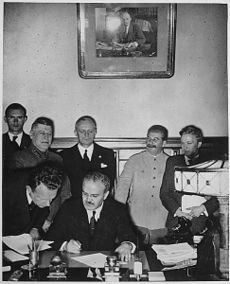
Appeasement and pre-war alliances
The British and French governments followed a policy of appeasement in order to avoid a new European war. This was partially due to doubts about the willingness of their populations to fight another war so soon after the huge death tolls of the first World War. This policy culminated in the Munich Agreement in 1938, in which the seemingly inevitable outbreak of the war was averted when the United Kingdom and France agreed to Germany's annexation and immediate occupation of the German-speaking regions of Czechoslovakia. Chamberlain declared that the agreement represented "peace in our time". In March 1939, Germany invaded the rest of Czechoslovakia, effectively killing appeasement. Less than a year after the Munich agreement, the United Kingdom and France declared war on Germany.
The failure of the Munich Agreement showed that deals made with Hitler at the negotiating table could not be trusted and that his aspirations for power and dominance in Europe went beyond anything that England and France would tolerate. Poland and France pledged on May 19, 1939, to provide each other with military assistance in the event either was attacked. The British had already offered support to Poland in March. On August 23, 1939, Germany and the Soviet Union signed the Molotov-Ribbentrop Pact. The Pact included a secret protocol that would divide Central Europe into German and Soviet areas of interest, including a provision to partition Poland. Each country agreed to allow the other a free hand in its area of influence, including military occupation. The deal provided for sales of oil and food from the Soviets to Germany, thus reducing the danger of a UK blockade such as the one that had nearly starved Germany in World War I. Hitler was then ready to go to war with Poland and, if necessary, with the United Kingdom and France. He claimed there were German grievances relating to the issues of the Free City of Danzig and the Polish Corridor, but he planned to conquer all Polish territory and incorporate it into the German Reich. The signing of a new alliance between the United Kingdom and Poland on August 25 did not significantly alter his plans.
German and Soviet invasion of Poland
On September 1, 1939, Germany invaded Poland, using the false pretext of a faked " Polish attack" on a German border post.
On September 3, the United Kingdom and France declared war on Germany, followed quickly by Canada, Australia, and New Zealand.
The French mobilized slowly and then mounted only a token offensive in the Saar, which they soon abandoned, while the British could not take any direct action in support of the Poles in the time available (see Western betrayal). Meanwhile, on September 8, the Germans reached Warsaw, having slashed through the Polish defenses.
On September 17, the Soviet Union, pursuant to its secret agreement with Germany, invaded Poland from the east, throwing Polish defences into chaos by opening the second front. A day later, both the Polish president and commander-in-chief fled to Romania. On October 1, hostile forces, after a one-month siege of Warsaw, entered the city. The last Polish units surrendered on October 6. Poland, however, never officially surrendered to the Germans. Some Polish troops evacuated to neighboring countries. In the aftermath of the September Campaign, occupied Poland managed to create a powerful resistance movement and contributed significant military forces to the Allies for the duration of World War II.
Phony War
After Poland fell, Germany paused to regroup during the winter of 1939-1940 until April 1940, while the British and French stayed on the defensive. The period was referred to by journalists as “the Phony War” or the “Sitzkrieg” because so little ground combat took place.
Battle of the Atlantic
Meanwhile in the North Atlantic, German U-boats operated against Allied shipping. The submarines made up in skill, luck, and courage what they lacked in numbers. One U-boat sank the British carrier HMS Courageous, while another U-boat managed to sink the battleship HMS Royal Oak in its home anchorage of Scapa Flow. Altogether, the U-boats sank more than 110 vessels in the first four months of the war. The most damaging effect of the U-boats was in sinking transatlantic merchant shipping.
After 1943, Germany had no serious chance of victory at sea. The Allies produced ships faster than they were sunk, and lost fewer ships by adopting the convoy system. Improved anti-submarine warfare meant that the life expectancy of a typical U-boat crew would be measured in months. The vastly improved Type 21 U-boat appeared as the war was ending, but too late.
In the South Atlantic, the Admiral Graf Spee sank nine UK Merchant Navy vessels. She was then engaged by British cruisers HMS Ajax, HMS Exeter, and HMNZS Achilles in the Battle of the River Plate, and forced into Montevideo Harbour. Rather than face battle again, Captain Langsdorff made for sea and scuttled his battleship just outside the harbour.
Pacific Theatre
Sino-Japanese War
The Second Sino-Japanese War began in 1937, when Japan attacked deep into China from its foothold in Manchuria. On July 7, 1937, Japan, after occupying Manchuria since 1931, launched another attack against China near Beiping (now Beijing). The Japanese made initial advances but were stalled in the Battle of Shanghai. The city eventually fell to the Japanese in December 1937, and the capital city Nanjing (Nanking) also fell. As a result, the Chinese government moved its seat to Chongqing for the remainder of the war. The Japanese forces committed brutal atrocities against civilians and prisoners of war in the Rape of Nanking, slaughtering as many as 300,000 civilians within a month.
Second Russo-Japanese War
On May 8, 1939, 700 Mongol horsemen crossed the Khalka river, which the Japanese considered to be the Manchurian border. The Soviet and Mongolian governments believed the border was twenty miles to the east. Mongol and Manchu forces began to shoot at each other, and within days their Soviet and Japanese patrons had sent large military contingents, which almost immediately joined in the clash, which led to a full-scale war which lasted well into September, and Soviet fear of having to fight a two front war was a primary reason for the Molotov-Ribbentrop Pact with the Nazis. The Japanese would suffer approximately 18,000 casualties, the Soviet-Mongolian forces 9,000.
War spreads: 1940
European Theatre
Soviet-Finnish War and occupation of Baltic Republics
In a secret Soviet-German agreement, Finland was designated a Soviet buffer zone, and the Soviets attacked on November 30, 1939, which started the Winter War. Despite outnumbering Finnish troops by 4 to 1, the Red Army found the attack embarrassingly difficult, and the Finnish defence prevented an all-out invasion. Finally, however, the Soviets prevailed and the peace treaty saw Finland cede strategically important border areas near Leningrad. The war triggered an international outcry, and, on December 14, the Soviet Union was expelled from the League of Nations. In June 1940, the Soviet Union occupied Latvia, Lithuania, and Estonia, sending the local leadership to the Gulag; in addition, it annexed Bessarabia and Northern Bukovina from Romania.
German invasion of Denmark and Norway
Germany invaded Denmark and Norway on April 9, 1940, in Operation Weserübung, in part to counter the threat of an impending Allied invasion of Norway. Denmark did not resist, but Norway fought back. The United Kingdom, whose own invasion was ready to launch, landed in the north. By late June, the Allies were defeated and withdrew, Germany controlled most of Norway, and the Norwegian Army had surrendered, while the royal family escaped to London. Germany used Norway as a base for air and naval attacks on Arctic convoys headed to the Soviet Union.
German invasion of France and the Low Countries
On May 10, 1940, the Germans invaded Luxembourg, Belgium, the Netherlands, and France, ending the Phony War. The British Expeditionary Force (BEF) and the French Army advanced into northern Belgium and planned to fight a mobile war in the north, while maintaining a static continuous front along the Maginot Line further south. The Allied plans were immediately smashed by the most classic example in history of Blitzkrieg. The Dutch city of Rotterdam was destroyed in a bombing raid.
In the first phase of the invasion, Fall Gelb (CACA), the Wehrmacht's Panzergruppe von Kleist, raced through the Ardennes, a heavily forested region which the Allies had thought impenetrable for a modern, mechanized army. The Germans broke the French line at Sedan, held by reservists rather than first-line troops, then drove west across northern France to the English Channel, splitting the Allies in two. Meanwhile, Belgium, Luxembourg, and the Netherlands fell quickly following the attack of German Army Group B.
The BEF and French forces, encircled in the north, were evacuated from Dunkirk in Operation Dynamo. The operation was one of the biggest military evacuations in history, as 338,000 British and French troops were transported across the English Channel on warships and civilian boats.

On June 10, Italy joined the war, attacking France in the south. German forces then continued the conquest of France with Fall Rot (Case Red). France signed an armistice with Germany on June 22, 1940, leading to the direct German occupation of Paris and two-thirds of France, and the establishment of a neutral (but pro-German) state headquartered in southeastern France known as Vichy France.
Battle of Britain
Germany had begun preparations in summer of 1940 to invade the United Kingdom in Operation Sea Lion. Most of the UK Army's heavy weapons and supplies had been lost at Dunkirk. The Germans had no hope of overpowering the Royal Navy, but they did think they had a chance of success, if they could gain air superiority. To do that, they first had to deal with the Royal Air Force. The ensuing contest in the late Summer of 1940 between the two air forces became known as the Battle of Britain. The Luftwaffe initially targeted RAF Fighter Command aerodromes and radar stations. Hitler, angered by retaliatory UK bombing raids on Berlin, switched his attentions towards the bombing of London, in an operation known as The Blitz. The Luftwaffe was eventually beaten back by Hurricanes and Spitfires, while the Royal Navy remained in control of the English Channel. Thus, the invasion plans were cancelled indefinitely, as Hitler turned to the East.
Italian invasion of Greece
Italy invaded Greece on October 28, 1940, from Italian occupied Albania. The Greek army forced the Italians to retreat back to Albania. By mid-December, the Greeks occupied one-quarter of Albania, tying down 530,000 Italians. Meanwhile, in fulfillment of Britain's guarantee to Greece the Royal Navy struck at the Italian fleet. Torpedo bombers from British Aircraft Carriers attacked the Italian fleet in the southern port of Taranto. One battleship was sunk and several other ships were put temporarily out of action. The success of aerial torpedoes at Taranto was noted with interest by Japan's naval chief, Yamoto, who was considering ways of "taking out" the U.S. Pacific fleet.
North Africa
With the French fleet neutralized, the UK Royal Navy battled the Italian fleet for supremacy in the Mediterranean. The British had strong bases at Gibraltar, Malta, and Alexandria, Egypt. In Africa, Italian troops invaded and captured British Somaliland in August. In September, the North African Campaign began when Italian forces in Libya attacked British forces in Egypt. The aim was to capture the Suez Canal, a vital link between the United Kingdom and India. UK, Indian, and Australian forces counter-attacked in Operation Compass, but this offensive stopped in 1941 when much of the Australian and New Zealand forces were transferred to Greece to defend it from German attack. German forces (known later as the Afrika Korps) under General Erwin Rommel, however, landed in Libya and renewed the assault on Egypt.
Pacific Theatre
Sino-Japanese War
By 1940, the war had reached a stalemate with both sides making minimal gains. The United States provided heavy financial support for China and set up the Flying Tigers air unit to bolster Chinese air forces.
Southeast Asia
Japanese forces invaded northern parts of French Indo-China on September 22. The move was not unexpected, and followed a demand for bases in the region made two months earlier. Japanese relations with the west had deteriorated steadily in recent years and United States, having renounced the U.S.-Japanese trade treaty of 1911, placed embargoes on exports to Japan of war and other materials.
War becomes global: 1941
European Theatre
Lend-Lease
After France had fallen in 1940, the United Kingdom was out of money. Franklin Roosevelt persuaded the U.S. Congress to pass the Lend-Lease act on March 11, 1941, which provided the United Kingdom and 37 other countries with US$5 billion dollars in military equipment and other supplies, US$3.4 billion of it going to the United Kingdom and the Commonwealth.
Canada operated a similar program that sent $4.7 billion in supplies to the United Kingdom.
German invasion of Yugoslavia and Greece
On April 6, 1941, German, Italian, Hungarian, and Bulgarian forces invaded Yugoslavia, ending with the surrender of the Yugoslavian army on April 17, and the creation of a puppet state in Croatia. Two rival resistance movements endured in Yugoslavia for the remainder of the war. The Communist group, AVNOJ, led by Tito finally prevailed over the Chetniks led by Draža Mihailović. Also on April 6, Germany invaded Greece from Bulgaria. The Greek army was outnumbered and collapsed. Athens fell on April 27, yet the United Kingdom managed to evacuate over 50,000 troops. The stubborn Greek resistance and the attack on Yugoslavia, however, delayed the German invasion of the Soviet Union by a critical six weeks.
German airborne invasion of Crete
Nazi Germany invaded the island with soldiers from the elite divisions of the 7th Flieger Division and 5 Mountain Division. Crete was defended by about 11,000 Greek and 28,000 ANZAC troops (see Creforce), who had just escaped Greece without their artillery or vehicles. The Germans attacked the three main airfields of the island of Maleme, Rethimnon, and Heraklion. After one day of fighting, none of the objectives were reached and the Germans had suffered appalling casualties. German plans were in disarray and Commanding General Kurt Student was contemplating suicide. During the next day, through miscommunication and failure of Allied commanders to grasp the situation, Maleme airfield in western Crete fell to the Germans. The loss of Maleme enabled the Germans to fly in heavy reinforcements and overwhelm the Allied forces on the island. In light of the heavy casualties suffered by the parachutists, however, Adolf Hitler forbade further airborne operations.
German invasion of the Soviet Union
From the signing of the Molotov-Ribbentrop Pact in August, 1939, through half of 1941, Stalin and the Soviet Union fed and equipped Hitler and Germany as Germany invaded Western Europe and attacked the United Kingdom by air. Germany then betrayed its Soviet partner.
On June 22, 1941, Operation Barbarossa began, the largest military invasion in history. Three German Army Groups, an Axis force of over four million men, advanced rapidly deep into the Soviet Union, destroying almost the entire western Red Army in huge battles of encirclement. Nevertheless, the Soviets dismantled as much industry as possible ahead of the advancing Axis forces, moving it to areas east of the Ural Mountains for reassembly, and ultimately resupplying the Soviet armies and contributing mightily to the destruction of Germany. By late November, the Axis had reached a line at the gates of Leningrad, Moscow, and Rostov, at the cost of about 23 percent casualties. Their advance then ground to a halt as the harsh Russian winter set in. The German General Staff had underestimated the size of the Soviet army and its ability to draft new troops. German soldiers were ill-equipped for harsh weather, and logistics were poor because of the distances, the rudimentary rail and road system, and the breakdown of men, animals and machinery in extreme cold.
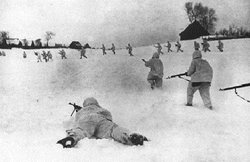
German forward units had advanced within sight of Moscow's Saint Basil's Cathedral, but on December 5, the Soviets counterattacked and pushed the Axis back some 150-250 kilometers (100-150 mi), the first major German defeat of World War II.
Meanwhile, on June 25, the Continuation War between Finland and the Soviet Union began with Soviet air attacks shortly after the beginning of Operation Barbarossa.
Allied conferences
The Atlantic Charter was issued as a joint declaration by Franklin Roosevelt and Winston Churchill, at Argentia, Newfoundland, on August 14, 1941.
In December 1941, after the United States entered the war, Churchill and Roosevelt met Stalin at the Arcadia Conference. They agreed that defeating Germany had priority over defeating Japan. To relieve German pressure on Russia, the US proposed a 1942 cross-channel invasion of France, which the British strongly opposed, suggesting instead a small invasion of Norway or landings in French North Africa. The Declaration by the United Nations was issued.
North Africa and the Middle East
In North Africa, Rommel's forces advanced rapidly eastward, laying siege to the vital seaport of Tobruk. Two Allied attempts to relieve Tobruk were defeated, but a larger offensive at the end of the year ( Operation Crusader) drove Rommel back after heavy fighting.
In April-May 1941, there a was short war in Iraq that resulted in a renewal of UK occupation. In June, Allied forces invaded Syria and Lebanon and captured Damascus on June 17. Later, in August, UK and Red Army troops occupied neutral Iran, securing its oil and a southern supply line to the Soviet Union.
Mediterranean
Good Intelligence accounted for a British victory on March 28 in the largest naval battle of the war so far, when Admiral Cunningham's ships encountered the main Italian fleet south of Cape Matapan, at the southern extremity of the Greek mainland. At the cost of a couple of aircraft shot down, the British sank five Italian cruisers and three destroyers. The Italian navy was emasculated as a fighting force, and the British task of moving troops across the Mediterranean to Greece was eased.
Battle of the Atlantic
On May 9, the UK destroyer HMS Bulldog captured a German U-Boat and recovered a complete, intact Enigma Machine. This was a vital for the Allies in the Battle of the Atlantic (1939-1945), and in their code-breaking efforts. The machine was taken to Bletchley Park, where it was used to help decipher and understand German encryption techniques.
On May 24, the German battleship Bismarck left port, threatening British shipping in the Atlantic. After UK battlecruiser HMS Hood was sunk in the Battle of the Denmark Strait, the Royal Navy engaged in a massive hunt across the North Atlantic for Bismarck. The German battleship was sunk after a 1,700-mile (2,700 kilometers) chase in which the British employed eight battleships and battle cruisers, two aircraft carriers, 11 cruisers, 21 destroyers, and six submarines. After an extensive chase, Fairey Swordfish torpedo bombers from aircraft carrier HMS Ark Royal struck the Bismarck, resulting in only minor damage to the ship, but causing her rudder to jam and allowing the pursuing Royal Navy squadrons to catch and sink her.
Pacific Theatre
Japan and United States enter the War
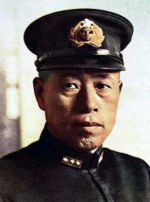
In the summer of 1941, the United States, the United Kingdom, and the Netherlands began an oil embargo against Japan, threatening its ability to fight a major war at sea or in the air. However, Japanese forces continued to advance into China. Japan planned an attack on Pearl Harbour to cripple the U.S. Pacific Fleet, then seize oil fields in the Dutch East Indies. On December 7, a Japanese carrier fleet launched an unexpected air attack on Pearl Harbour, Hawaii. The raid destroyed most of the American aircraft on the island and knocked the main American battle fleet out of action (six battleships sank, but four of them along with two other badly damaged battleships eventually returned to service). However, the four American aircraft carriers that had been the intended main target of the Japanese attack were off at sea. At Pearl Harbour, the main dock, supply, and repair facilities were quickly repaired. Furthermore, the base's fuel storage facilities, whose destruction could have crippled the Pacific fleet, were untouched.
The attack united American public opinion to demand vengeance against Japan. The following day, December 8, the United States declared war on Japan. On the same day, Japan invaded Malaya, and China officially declared war against Japan. Disaster struck the British on the 10th, as they lost two major battleships, HMS Prince of Wales and HMS Repulse. Both ships had been attacked by 85 Japanese bombers and torpedo planes based in Saigon, and 840 UK sailors perished. Churchill was to say of the event, "In all of the war I have never received a more direct shock."
Germany declared war on the United States on December 11, even though it was not obliged to do so under the Tripartite Pact. Hitler hoped that Japan would support Germany by attacking the Soviet Union. Japan did not oblige because it had signed a non-aggression treaty with the Soviet Union. Instead, Germany's declaration largely removed any significant opposition to the United States' joining the fight in the Europe Theatre with full commitment.
Japanese offensive
Less than 24 hours after the Attack on Pearl Harbour, Japan invaded Hong Kong. The Philippines and the British colonies of Malaya, Borneo, and Burma soon followed, with Japan's intention of seizing the oilfields of the Dutch East Indies. Despite fierce resistance by Philippine, Australian, New Zealand, British, Canadian, Indian, and American forces, all these territories capitulated to the Japanese in a matter of months. The British island fortress of Singapore was captured in what Churchill considered one of the most humiliating British defeats of all time.
Deadlock: 1942
European Theatre
- Western and Central Europe
In May, the architect of the Final Solution, Reinhard Heydrich, was assassinated by Czech resistance agents in Operation Anthropoid. Hitler ordered severe reprisals against the occupants of the nearby Czechoslovakian village of Lidice.
On August 19, Allied forces, mainly Canadian, launched the Dieppe Raid (codenamed Operation Jubilee) on the German-occupied port of Dieppe, France. The attack was an Allied disaster, but provided critical information utilized later in Operation Torch and Operation Overlord.
- Soviet winter and early spring offensives
In the north, the Red Army launched the Toropets-Kholm Operation January 9 to February 6 1942, trapping a German force near Andreapol. The Soviets also surrounded a German garrison in the Demyansk Pocket, which held out with air supply for four months ( February 8 until April 21), and established themselves in front of Kholm, Velizh, and Velikie Luki.
In the south, Soviet forces launched an offensive in May against the German Sixth Army, initiating a bloody 17-day battle around Kharkov which resulted in the loss of over 200,000 Red Army personnel.
- Axis summer offensive
On June 28, the Axis began their summer offensive, Operation Blue, a planned drive southeast from the Don river to the Volga river toward the Caucasus mountains. German Army Group B planned to capture the city of Stalingrad, which would secure the German left flank, while Army Group A planned to capture the southern oil fields. In the Battle of the Caucasus, fought in the late summer and fall of 1942, the Axis forces captured the oil fields.
- Stalingrad
On August 23, the Germans reached the Volga north of Stalingrad. German bombing virtually destroyed the wooden buildings of the city which flanked the central strip, containing large modern factories. By September 23 the main factory complex was surrounded and the German artillery was within range of the quays on the river, across which the Soviets evacuated wounded and brought in reinforcements. Ferocious street fighting, hand-to-hand conflict of the most savage kind, now ensued at Stalingrad. Exhaustion and deprivation gradually sapped men's strength. Hitler, who had become obsessed with the battle of Stalingrad, refused to countenance a withdrawal. Von Paulus, in desperation, launched yet another attack early in November by which time the Germans had managed to capture 90% of the city. The Soviets, however, had been building up massive forces on the flanks of Stalingrad which were by this time severely undermanned as the bulk of the German forces had been concentrated in capturing the city. They launched Operation Uranus on November 19, with twin attacks that met at the city of Kalach four days later and trapped the Sixth Army in Stalingrad.
The Germans requested permission to attempt a break-out, which was refused by Hitler, who ordered Sixth Army to remain in Stalingrad where he promised they would be supplied by air until rescued. About the same time, the Soviets launched Operation Mars in a salient near the vicinity of Moscow. Its objective was to tie down Army Group Centre and to prevent it from reinforcing Army Group South at Stalingrad.
In December, Von Manstein hastily put together a German relief force of units composed from Army Group South to relieve the trapped Sixth Army. Unable to get reinforcements from Army Group Centre, the relief force only managed to get within 50 kilometers (30 mi) before they were turned back by the Soviets. By the end of the year, Sixth Army was in desperate condition, as the Luftwaffe was able to supply only about a sixth of the supplies needed.
Shortly before surrendering to the Red Army on February 2, 1943, Friedrich von Paulus was promoted to Fieldmarshall. This was a message from Hitler, because no German Fieldmarshall had ever surrendered his troops or been taken alive. Only 91,000 German prisoners were taken, including 22 generals of which only 5,000 men ever returned to Germany after the war. This was to be the greatest, and most costly battle in terms of human life, in world history. Around 2 million men were killed or wounded on both sides, including civilians, with Axis casualties estimated to be approximately 850,000.
- Eastern North Africa
At the beginning of 1942, the Allied forces in North Africa were weakened by detachments to the Far East. Rommel once again attacked and recaptured Benghazi. Then, he defeated the Allies at the Battle of Gazala, and captured Tobruk along with several thousand prisoners and large quantities of supplies. Following up, he drove deep into Egypt.
The First Battle of El Alamein took place in July 1942. Allied forces had retreated to the last defensible point before Alexandria and the Suez Canal. The Afrika Korps, however, had outrun its supplies, and the defenders stopped its thrusts. The Second Battle of El Alamein occurred between October 23 and November 3. Lieutenant-General Bernard Montgomery was in command of Allied forces known as the British Eighth Army. The Eighth Army took the offensive and was ultimately triumphant. After the German defeat at El Alamein, the Axis forces made a successful strategic withdrawal to Tunisia.
Western North Africa
Operation Torch was launched by the U.S., British and Free French forces on November 8, 1942. It aimed to gain control of North Africa through simultaneous landings at Casablanca, Oran, and Algiers, followed a few days later with a landing at Bône, the gateway to Tunisia. The local forces of Vichy France put up minimal resistance before submitting to the authority of Free French General Henri Giraud. In retaliation, Hitler invaded and occupied Vichy France. The German and Italian forces in Tunisia were caught in the pincers of Allied advances from Algeria in the west and Libya in the east. Rommel's tactical victory against inexperienced American forces at the Battle of the Kasserine Pass only postponed the eventual surrender of the Axis forces in North Africa.
Pacific Theatre
Central and Southwest Pacific
On February 19, 1942, Roosevelt signed United States Executive Order 9066, leading to the internment of thousands of Japanese, Italians, German Americans, and some emigrants from Hawaii who fled after the bombing of Pearl Harbour for the duration of the war.
In April, the Doolittle Raid, the first U.S. air raid on Tokyo, boosted morale in the United States and caused Japan to shift resources to homeland defense, but did little physical damage.
In early May, a Japanese naval invasion of Port Moresby, New Guinea, was thwarted by Allied navies in the Battle of the Coral Sea. This was both the first successful opposition to a Japanese attack and the first battle fought between aircraft carriers. The U.S. did however lose the major aircraft carrier USS Lexington, giving Japan a tactical victory.
A month later, on June 5, U.S. carrier-based dive-bombers sank four of Japan's best aircraft carriers in the Battle of Midway, a major victory for the United States. Historians mark this battle as a turning point and the end of Japanese expansion in the Pacific. Cryptography played an important part in the battle, as the United States had broken the Japanese naval codes and knew the Japanese plan of attack.
In July, a Japanese overland attack on Port Moresby was led along the rugged Kokoda Track. An outnumbered, untrained and ill equipped Australian battalion defeated the 5,000-strong Japanese force, the first land defeat of Japan in the war and one of the most significant victories in Australian military history.
Between late July and mid September, Australian forces, hampered by the terrain and the inefficiencies of High command, fought back two concerted Japanese thrusts towards Port Moresby, the Battle of Milne Bay and the Kokoda Track.
The battle for Kokoda was a costly and desperate battle. The Australian forces, under the command of AIF officers, held back the Japanese forces long enough for the 21st Brigade to reinforce the ravaged militia.
On August 7, U.S. Marines began the Battle of Guadalcanal. For the next six months, U.S. forces fought Japanese forces for control of the island. Meanwhile, several naval encounters raged in the nearby waters, including the Battle of Savo Island, Battle of Cape Esperance, Naval Battle of Guadalcanal, and Battle of Tassafaronga.
In late August and early September, while battle raged on Guadalcanal, an amphibious Japanese attack on the eastern tip of New Guinea was met by Australian forces in the Battle of Milne Bay.
Sino-Japanese War
Japan launched a major offensive in China following the attack on Pearl Harbour. The aim of the offensive was to take the strategically important city of Changsha, which the Japanese had failed to capture on two previous occasions. For the attack, the Japanese massed 120,000 soldiers under four divisions. The Chinese responded with 300,000 men, and soon the Japanese army was encircled and had to retreat.
War turns: 1943
European Theatre
Soviet and German spring offensives
After the surrender of the German Sixth Army at Stalingrad on February 2, 1943, the Red Army launched eight offensives during the winter. Many were concentrated along the Don basin near Stalingrad. These attacks resulted in initial gains until German forces were able to take advantage of the over extended and weakened condition of the Red Army and launch a counter attack to re-capture the city of Kharkov and surrounding areas. This was to be the last major strategic German victory of World War II.
German summer offensive
The rains of spring inhibited campaigning in the Soviet Union, but both sides used the interval to build up for the inevitable battle that would come in the summer. The start date for the offensive had been moved repeatedly as delays in preparation had forced the Germans to postpone the attack. By July 4, the Wehrmacht after assembling their greatest concentration of firepower during the whole of World War II, launched their offensive against the Soviet Union at the Kursk salient. Their intentions were known by the Soviets, who hastened to defend the salient with an enormous system of earthwork defenses. The Germans attacked from both the north and south of the salient and hoped to meet in the middle, cutting off the salient and trapping 60 Soviet divisions. The German offensive in the Northern sector was ground down as little progress was made through the Soviet defenses but in the Southern Sector there was a danger of a German breakthrough. The Soviets then brought up their reserves, and the ensuing Battle of Kursk became the largest tank battle of the war, near the city of Prokhorovka. The Germans lacking any sizable reserves had exhausted their armored forces and could not stop the Soviet counteroffensive that threw them back across their starting positions.
Soviet fall and winter offensives
The Soviets captured Kharkov following their victory at Kursk and with the Autumn rains threatening, Hitler agreed to a general withdrawal to the Dnieper line in August. As September proceeded into October, the Germans found the Dnieper line impossible to hold as the Soviet bridgeheads grew. Important Dnieper towns started to fall, with Zaporozhye the first to go, followed by Dnepropetrovsk. Early in November the Soviets broke out of their bridgeheads on either side of Kiev and recaptured the Ukrainian capital. The 1st Ukrainian Front attacked at Korosten on Christmas Eve, and the Soviet advance continued along the railway line until the 1939 Soviet-Polish border was reached.
Allied invasion of Italy
The surrender of Axis forces in Tunisia on May 13, 1943, yielded some 250,000 prisoners. The North African war proved to be a disaster for Italy, and when the Allies invaded Sicily on July 10 in Operation Husky, capturing the island in a little over a month, the regime of Benito Mussolini collapsed. On July 25, he was removed from office by Victor Emmanuel III, the King of Italy, and arrested with the positive consent of the Great Fascist Council. A new government, led by Pietro Badoglio, took power and declared ostensibly that Italy would stay in the war. Badoglio had already begun secret peace negotiations with the Allies.
The Allies invaded mainland Italy on September 3, 1943. Italy surrendered to the Allies on September 8, as had been agreed in negotiations. The royal family and Badoglio government escaped to the south, leaving the Italian army without orders, while the Germans took over the fight, forcing the Allies to a complete halt in the winter of 1943-44 at the Gustav Line south of Rome.
In the north, Mussolini, with Nazi support, created what was effectively a puppet state, the Italian Social Republic or Republic of Salò, named after the new capital of Salò on Lake Garda.
Mid-1943 brought the fifth and final German Sutjeska offensive against the Yugoslav partisans.
Battle of the Atlantic
The turning point of the Battle of the Atlantic took place in early 1943 as the Allies refined their naval tactics, effectively making use of new technology to counter the U-Boats. Although two convoys suffered heavy losses, the U-Boats were also taking increasingly heavy casualties, and were forced to abandon their main offensive in the mid-Atlantic.
The Allies had also resumed running the Arctic convoys to the Soviet Union. In December, the last major sea battle between the Royal Navy and the German Navy took place. At the Battle of North Cape, Germany's last battlecruiser, the Scharnhorst, was sunk by HMS Duke of York, HMS Belfast, and several destroyers.
Pacific Theatre
Central and Southwest Pacific
On January 2, Buna, New Guinea, was captured by the Allies. This event ended the threat to Port Moresby. By January 22, 1943, the Allied forces had achieved their objective of isolating Japanese forces in eastern New Guinea and cutting off their main line of supply.
American authorities declared Guadalcanal secure on February 9. Australian and U.S. forces undertook the prolonged campaign to retake the occupied parts of the Solomon Islands, New Guinea, and the Dutch East Indies, experiencing some of the toughest resistance of the war. The rest of the Solomon Islands were retaken in 1943.
In November, U.S. Marines won the Battle of Tarawa. This was the first heavily opposed amphibious assault in the Pacific theatre. The high casualties taken by the Marines sparked off a storm of protest in the United States, where the large losses could not be understood for such a tiny and seemingly unimportant island. This led to the adoption of the " Island hopping" strategy, where the Allies bypassed some Japanese island strongholds and let them "wither on the vine", cut off from supplies and troop reinforcements.
Sino-Japanese War
A vigorous, fluctuating battle for Changde in China's Hunan province began on November 2, 1943. The Japanese threw over 100,000 men into the attack on the city, which changed hands several times in a few days but ended up still held by the Chinese. Overall, the Chinese ground forces were compelled to fight a war of defense and attrition while they built up their armies and awaited an Allied counteroffensive.
Southeast Asia
The Chinese Nationalist Kuomintang Army, under Chiang Kai-shek, and the Communist Chinese Army, under Mao Zedong, both opposed the Japanese occupation of China, but never truly allied against the Japanese. Conflict between Nationalist and Communist forces emerged long before the war; it continued after and, to an extent, even during the war, though less openly.
The Japanese had captured most of Burma, severing the Burma Road by which the Western Allies had been supplying the Chinese Nationalists. This loss forced the Allies to create a large sustained airlift from India, known as "flying the Hump". Under the American General Joseph Stilwell, Chinese forces in India were retrained and re-equipped, while preparations were made to drive the Ledo Road from India to replace the Burma Road. This effort was to prove an enormous engineering task.
Beginning of the end: 1944
European Theatre
Soviet winter and spring offensives
In the northwest, a Soviet offensive in January 1944 had relieved the siege of Leningrad. The Germans conducted an orderly retreat from the Leningrad area to a shorter line based on the lakes to the south.
In the south, in March, two Soviet formations encircled Generaloberst Hans-Valentin Hube's First Panzer Army north of the Dniestr river. The Germans escaped the pocket in April, saving most of their men but losing their heavy equipment.
In early May, the Red Army's 3rd Ukrainian Front engaged German Seventeenth Army of Army Group South which had been left behind after the German retreat from the Ukraine. The battle was a complete victory for the Red Army, and a botched evacuation effort across the Black Sea led to over 250,000 German and Romanian casualties.
During April 1944, a series of attacks by the Red Army near the city of Iaşi, Romania, aimed at capturing the strategically important sector. The German-Romanian forces successfully defended the sector throughout the month of April. The attack at Târgul Frumos was the final attempt by the Red Army to achieve its goal of having a springboard into Romania for a summer offensive.
With Soviet forces approaching, German troops occupied Hungary on March 20. Hitler thought that Hungarian leader Admiral Miklós Horthy might no longer be a reliable ally.
Finland sought a separate peace with Stalin in February 1944, but would not accept the initial terms offered. On June 9, the Soviet Union began the Fourth strategic offensive on the Karelian Isthmus that, after three months, forced Finland to accept an armistice.
Italy and the Balkans
Following Italy's surrender, German troops took over the defense of the Italian peninsula and established the Gustav line in the southern Apennine Mountains south of Rome. The Allies were unable to break this line, and so attempted to bypass it with an amphibious landing at Anzio on January 22, 1944. The landing, named Operation Shingle, quickly became encircled by the Germans and bogged down, leading Churchill to comment, "Instead of hurling a wildcat onto the shore all we got was a stranded whale."
Unable to circumvent the Gustav line, the Allies again attempted to break through with frontal assaults. On February 15, the monastery of Monte Cassino, founded in 524 by St. Benedict was destroyed by American B-17 and B-26 bombers, upon the erroneous belief that the Germans made use of it for artillery spotting. Two days after the bombing, crack German paratroopers poured into the ruins to defend it. From January 12 to May 18, it was assaulted four times by Allied troops, for a loss of over 54,000 Allied and 20,000 German soldiers.
After months, the Gustav line was broken and the Allies marched north. On June 4, Rome was liberated, and the Allied army reached Florence in August. It then was held at the Gothic Line on the Tuscan Apennines during the winter.
Germany withdrew from the Balkans and held Hungary until February 1945.
Romania turned against Germany in August 1944, threatening German lines of retreat from the Ukraine. Bulgaria surrendered in September.
V Weapons
In June 1944, the Germans used the world's first cruise missile, the V-1 flying bomb, to attack UK targets. Later, they would employ the V-2 rocket, a liquid-fuelled guided ballistic missile.
Area bombing raids
The U.S., UK, and Canadian air forces counterattacked the Luftwaffe and began large-scale strategic bombing, eventually targeting major cities inside Germany. This effort was orchestrated by Air Chief Marshall Harris, who became known as 'Bomber Harris'. Additionally, Winston Churchill ordered "terror raids" intended to wipe out whole cities in one go, by incendiary devices causing firestorms, thus depriving German workers of their homes. Mass raids involving upwards of 500 to 1000 heavy bombers at a time were undertaken against airfields, industrial centers, submarine bases, rail-marshalling yards, oil depots and, in the later stages of the war, launching sites for weapons such as the V-1 missile ( nicknamed 'doodlebug'), the V-2 rocket and a jet-engined plane, the Messerschmitt Me 262. The Luftwaffe was overwhelmed and had only a few operational planes left by late 1944 on the Western Front. By 1945, all major German cities were burnt-out ruins.
Soviet summer offensive
Operation Bagration, a Soviet offensive involving 2.5 million men and 6,000 tanks, was launched on June 22, 1944. Its objective was to clear German troops from Belarus. The subsequent battle resulted in the destruction of German Army Group Centre and over 800,000 German casualties, the greatest defeat for the Wehrmacht during the war. The Soviets swept forward, reaching the outskirts of Warsaw on July 31.
Warsaw Uprising
The proximity of the Red Army led the Poles in Warsaw to believe they would soon be liberated. On August 1, they revolted as part of the wider Operation Tempest. Nearly 40,000 Polish resistance fighters seized control of the city. The Soviets, however, did not advance any further. The only assistance given to the Poles was artillery fire, as German army units moved into the city to put down the revolt. The resistance ended on October 2. German units then destroyed most of what was left of the city.
Soviet autumn and winter offensives
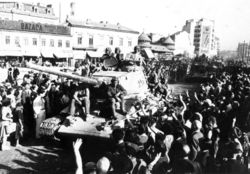
After the destruction of Army Group Centre, the Soviets attacked German forces in the south in mid-July 1944, and in a month's time they cleared Ukraine of German presence.
The Red Army's 2nd and 3rd Ukrainian Fronts engaged German Heeresgruppe Südukraine, which consisted of German and Romanian formations, in an operation to occupy Romania and destroy the German formations in the sector. The result of the battle was complete victory for the Red Army, and a switch of Romania from the Axis to the Allied camp.
In October 1944, General der Artillerie Maximilian Fretter-Pico's Sixth Army encircled and destroyed three corps of Marshal Rodion Yakovlevich Malinovsky's Group Pliyev near Debrecen, Hungary. This was to be the last German victory in the Eastern front.
The Red Army's 1st, 2nd, and 3rd Baltic Fronts engaged German Army Group Centre and Army Group North to capture the Baltic region from the Germans. The result of the series of battles was a permanent loss of contact between Army Groups North and Centre, and the creation of the Courland Pocket in Latvia. From December 29, 1944, to February 13, 1945, Soviet forces laid siege to Budapest, which was defended by German Waffen-SS and Hungarian forces. It was one of the bloodiest sieges of the war.
Allied invasion of Western Europe

On " D-Day" ( June 6, 1944), the western Allies of mainly the United States, the United Kingdom, and Canada invaded German-held Normandy. German resistance was stubborn, especially on Omaha Beach and in the city of Caen. During the first month, the Allies measured progress in hundreds of yards and bloody rifle fights in the Bocage. An Allied breakout ( Operation Cobra) was effected at St.-Lô.
During August 1944, the German Seventh Army and Fifth Panzer Army were almost completely encircled in the Falaise pocket after they mounted a counterattack. Some 50,000 were captured, but 100,000 managed to escape the pocket. Allied forces stationed in Italy invaded the French Riviera on August 15 and linked up with forces from Normandy. The clandestine French Resistance in Paris rose against the Germans on August 19, and a French division under General Jacques Leclerc, pressing forward from Normandy, received the surrender of the German forces there and liberated the city on August 25.
Allied autumn offensive
Logistical problems plagued the Allies' advance east as the supply lines still ran back to the beaches of Normandy. Allied paratroopers and armor attempted a war-winning advance through the Netherlands and across the Rhine River with Operation Market Garden in September, but they were repulsed. A decisive victory by the Canadian First Army in the Battle of the Scheldt secured the entrance to the port of Antwerp, which freed it to receive supplies by late November 1944. Meanwhile, the Americans launched an attack through the Hurtgen Forest in September, but the Germans despite having smaller numbers were able to use the difficult terrain and find good defensive positions. In October, the Americans captured Aachen, the first major German city to be occupied.
German winter offensive
In December 1944, the German Army made its last major offensive in the West, known as the Battle of the Bulge. Hitler sought victory similar to the 1940 Ardennes offensive, which he envisioned would drive back the Western Allies and force them to agree to a separate peace. At first, the Germans scored successes against the unprepared Allied forces. The lead group of panzers, Kampfgruppe Peiper led by Jochen Peiper, got so far out in front that he created a "bulge" in the American lines, hence the name of the battle.
Poor weather during the initial days of the offensive favored the Germans, because Allied aircraft were grounded. Stubborn U.S. resistance at St. Vith and by the surrounded 101st Airborne Division at Bastogne, an important crossroads, blunted the German advance. The arrival of the United States Third Army under General George Patton ended the German threat, and further counterattacks trapped many German units in the resulting pocket. The remaining Germans were forced to retreat back into Germany. It was the bloodiest battle in U.S. military history.
Pacific Theatre
Central and southwest Pacific
The American advance continued in the southwest Pacific with the capture of the Marshall Islands before the end of February. Some 42,000 U.S. Army soldiers and U.S. Marines landed on Kwajalein atoll on January 31. Fierce fighting occurred, and the island was taken on February 6. U.S. Marines next defeated the Japanese in the Battle of Eniwetok.
The U.S. strategic objective was to gain airbases within bombing range of the new B-29s on the Mariana Islands, especially Saipan, Tinian and Guam. On June 11, the U.S. Naval fleet bombarded Saipan, defended by 32,000 Japanese troops; 77,000 Marines landed starting the 15th, and the island was secure by July 9. The Japanese committed much of their declining naval strength in the Battle of the Philippine Sea, but suffered severe losses in both ships and aircraft. After the battle, the Japanese aircraft carrier force was no longer militarily effective. With the capture of Saipan, Japan was finally within range of B-29 bombers.
Guam was invaded on July 21 and taken on August 10, but the Japanese fought fanatically. Mopping-up operations continued long after the Battle of Guam was officially over. The island of Tinian was invaded on July 24 and was conquered on August 1. This operation saw the first use of napalm in the war.
General MacArthur's troops liberated the Philippines, landing on the island of Leyte on October 20. The Japanese had prepared a rigorous defense and used the last of their naval forces in a failed attempt to destroy the invasion force in the Battle of Leyte Gulf, October 23 through October 26, 1944, the largest naval battle in history. This was the first battle that employed Japanese kamikaze attacks. The Japanese battleship Musashi, one of the two largest battleships ever built, was sunk by 19 American torpedoes and 17 bombs.
Throughout 1944, U.S. submarines and aircraft attacked Japanese merchant shipping and deprived Japan's industry of the raw materials it had gone to war to obtain. The main target was oil, and Japan ran almost dry by late 1944. In 1944, submarines sank over two million tons of cargo, while the Japanese were only able to replace less than one million tons.
Sino-Japanese War
In April 1944, the Japanese launched Operation Ichigo to secure the railway route across Japanese-occupied territories of northeast China, Korea, and Southeast Asia, and to destroy U.S. airbases in the area. In June 1944, the Japanese deployed 360,000 troops and invaded Changsha for the fourth time. This campaign involved more Japanese troops than any other in the Sino-Japanese war, and after 47 days of bitter fighting, the city was taken. By November, the Japanese had also taken the cities of Guilin and Liuzhou, which had served as U.S. airbases for bombing raids on Japan. However, the USAAF could still strike Japan from newly acquired bases. By December, Japanese forces reached French Indochina and achieved the purpose of the operation, but only after incurring heavy losses.
Southeast Asia
While the Americans steadily built the Ledo Road from India to China, in March 1944, the Japanese began their own offensive into India. This "march to Delhi" was instigated by local commanders, and the leadership of the Japanese auxiliaries, the Indian National Army. The Japanese attempted to destroy the main British and Indian forces at Imphal, resulting in some of the most ferocious fighting of the war. While the encircled allied troops were reinforced and resupplied by transport aircraft until fresh troops broke the siege, the Japanese ran out of supplies and starved. They eventually retreated losing 85,000 men, one of the largest Japanese defeats of the war.
End of war: 1945
European Theatre
Soviet winter offensive
On January 12, the Soviet Army was ready for its next big offensive. Konev's armies attacked the Germans in southern Poland and expanded out from their Vistula River bridgehead near Sandomierz. On January 14, Rokossovsky's armies attacked from the Narew River north of Warsaw. They broke the defences covering East Prussia. Zhukov's armies in the centre attacked from their bridgeheads near Warsaw. The German front was now in shambles.
On January 17, Zhukov took Warsaw. On January 19, his tanks took Łódź. That same day, Konev's forces reached the German pre-war border. At the end of the first week of the offensive, the Soviets had penetrated 160 kilometers (100 mi) deep on a front that was 650 kilometers (400 mi) wide. By February 13, the Soviets took Budapest. The Soviet onslaught finally halted on the Oder River at the end of January, only 60 kilometers (40 mi) from Berlin.
Allied winter offensive
On January 14th, the XII Corps / 2nd British Army launched Operation Blackcock in order to clear the Roer Triangle, a German-held salient between the rivers Maas and Roer south of Roermond. By January 27th, the German forces were driven east of the Roer.
Yalta Conference
Meanwhile, Roosevelt, Churchill, and Stalin made arrangements for post-war Europe at the Yalta Conference in February 1945. Their meeting resulted in many important resolutions:
- An April meeting would be held to form the United Nations;
- Poland would have free elections;
- The borders of Poland were to be drastically moved westwards, at the expense of Germany.
- Soviet nationals were to be repatriated;
- The Soviet Union was to attack Japan within three months of Germany's surrender.
Soviet spring offensive
The Red Army (including 78,556 soldiers of the 1st Polish Army) began its final assault on Berlin on April 16. By April 24, three Soviet army groups completed the encirclement of the city. As a final resistance effort, Hitler called for civilians, including teenagers and the elderly, to fight in the Volkssturm militia against the oncoming Red Army. Those marginal forces were augmented by the battered German remnants that had fought the Soviets in Seelow Heights. The urban fighting was heavy, with house-to-house and hand-to-hand combat. The Soviets sustained 305,000 dead; the Germans sustained as many as 325,000, including civilians. Hitler and his staff moved into the Führerbunker, a concrete bunker beneath the Chancellery, where on April 30, 1945, he committed suicide, along with his bride, Eva Braun.
Allied spring offensive
The Allies resumed their advance into Germany in late January. The final obstacle to the Allies was the river Rhine, which was crossed in late March 1945, aided by the fortuitous capture of the Ludendorff Bridge at Remagen.
Once the Allies had crossed the Rhine, the British fanned out northeast towards Hamburg, crossing the river Elbe and moving on towards Denmark and the Baltic Sea. The U.S. Ninth Army went south as the northern pincer of the Ruhr encirclement, and the U.S. First Army went north as the southern pincer of the Ruhr encirclement. These armies were commanded by General Omar Bradley who had over 1,300,000 men under his control. On April 4, the encirclement was completed, and the German Army Group B commanded by Field Marshal Walther Model was trapped in the Ruhr Pocket. Some 300,000 German soldiers became prisoners of war. The First and Ninth U.S. armies then turned east. They halted their advance at the Elbe river where they met up with Soviet troops in mid-April.
Italy
Allied advances in the winter of 1944-45 up the Italian peninsula had been slow because of the mountains and troop re-deployments to France. By April 9, the British/American 15th Army Group broke through the Gothic Line and attacked the Po Valley, gradually enclosing the main German forces. Milan was taken by the end of April. The U.S. 5th Army continued to move west and linked up with French units. The New Zealand Second Division entered Trieste to confront Yugoslav partisans, who were intending to make the city part of Yugoslavia.
A few days before the surrender of German troops in Italy, Italian partisans captured Mussolini trying to make his escape to Switzerland. He was executed, along with his mistress, Clara Petacci. Their bodies were taken to Milan and hung upside down on public display.
Germany surrenders
Admiral Karl Dönitz became leader of the German government after the death of Hitler, but the German war effort quickly disintegrated. German forces in Berlin surrendered the city to Soviet troops on May 2, 1945.
The German forces in Italy surrendered on May 2, 1945, at General Alexander's headquarters, and German forces in northern Germany, Denmark, and the Netherlands surrendered on May 4. The surrender in Italy was preceded by the controversial secret Operation Sunrise in March 1945, during which the Great Britain and the United States were accused by the Soviet Union of trying to reach a separate peace. The German High Command under Generaloberst Alfred Jodl surrendered unconditionally all remaining German forces on May 7 in Rheims, France. The western Allies celebrated " V-E Day" on May 8.
The Soviet Union celebrated " Victory Day" on May 9. Some remnants of German Army Group Centre continued resistance until May 11 or May 12 (see Prague Offensive).
Potsdam
The last Allied conference of World War II was held at the suburb of Potsdam, outside Berlin, from July 17 to August 2. During the Potsdam Conference, agreements were reached among the Allies on policies for occupied Germany. An ultimatum was issued calling for the unconditional surrender of Japan.
Pacific Theatre
Central and Southwest Pacific
In January, the U.S. Sixth Army landed on Luzon, the main island of the Philippines. Manila was recaptured by March. U.S. capture of islands such as Iwo Jima in February and Okinawa (April through June) brought the Japanese homeland within easier range of naval and air attack. Amongst dozens of other Japanese cities, Tokyo was firebombed, and about 90,000 people died from the initial attack. The dense living conditions around production centres and the wooden residential constructions contributed to the large loss of life. In addition, the ports and major waterways of Japan were extensively mined by air in Operation Starvation, which seriously disrupted the logistics of the island nation.
The last major offensive in the South West Pacific Area was the Borneo campaign of mid-1945, which was aimed at further isolating the remaining Japanese forces in Southeast Asia and securing the release of Allied prisoners of war.
Southeast Asia
In Southeast Asia, during the monsoon from August to November 1944, the Japanese were pursued to the Chindwin River in Burma after their failed attack on India. With the onset of the dry season in early 1945, while the American and Chinese forces finally completed the Ledo Road, although too late to have any decisive effect, the British Fourteenth Army, consisting of Indian, British, and African units, launched an offensive into Central Burma. The Japanese forces were heavily defeated, and the Allies pursued them southward, taking Rangoon on May 2 (see Operation Dracula).
Atomic bombings of Hiroshima and Nagasaki
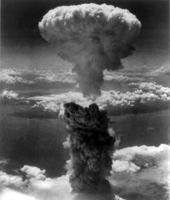
President Harry Truman decided to use the new atomic super-weapon to bring the war to a swifter end. The battle for Okinawa had shown that an invasion of the Japanese mainland (planned for November) would result large numbers of American casualties. The official estimate given to the Secretary of War was 1.4 to four million Allied casualties, though some historians dispute whether this would have been the case. Invasion would have meant the death of millions of Japanese soldiers and civilians, who were being trained as militia.
On August 6, 1945, a B-29 Superfortress, the Enola Gay, dropped a nuclear weapon dubbed Little Boy on Hiroshima, destroying the city. On August 9, a B-29 named Bockscar dropped the second atomic bomb, dubbed Fat Man, on the port city of Nagasaki.
Soviet offensive in the Far East
On August 8, two days after the atomic bomb was dropped on Hiroshima, the Soviet Union, having renounced its nonaggression pact with Japan, attacked the Japanese in Manchuria, fulfilling its Yalta pledge to attack the Japanese within three months after the end of the war in Europe. The attack was made by three Soviet army groups. In less than two weeks, the Japanese army in Manchuria, consisting of over a million men, had been destroyed by the Soviets. The Red Army moved into North Korea on August 18. Korea was subsequently divided at the 38th parallel into Soviet and U.S. zones.
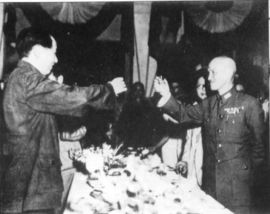
Japan surrenders
The American use of atomic weapons against Japan and the Soviet invasion of Manchukuo prompted Hirohito to bypass the existing government and intervene to end the war. In his radio address to the nation, the Emperor did not mention the entry of the Soviet Union into the war, but in his "Rescript to the soldiers and sailors" of August 17th, ordering them to cease fire and lay down arms, he stressed the relationship between Soviet entrance into the war and his decision to surrender, omitting any mention of the atomic bombs.
The Japanese surrendered on August 14, 1945, or V-J day, signing the Japanese Instrument of Surrender on September 2. The Japanese troops in China formally surrendered to the Chinese on September 9, 1945.
Casualties, civilian impact, and atrocities
Casualties
Some 62 million people, or 2.5% of the world population, died in the war, though estimates vary greatly - about 25 million soldiers and 37 million civilians. This total includes the estimated 12 million lives lost in the Holocaust. Of the total deaths in World War II, approximately 80% were on the Allied side and 20% on the Axis side.
Allied forces suffered approximately 17 million military deaths, of which about 10 million were Soviet and 4 million Chinese. Axis forces suffered about 8 million, of which more than 5 million were German. The Soviet Union suffered by far the largest death toll of any nation in the war; around 23 million people died in the Soviet Union, including more than 12 million civilians. Some modern estimates double the number of Chinese casualties originally mentioned.
The dead and missing among Allied uniformed personnel totaled about 14.2 million, including about 10 million from the USSR, 3 million from China, 400,000 from the British Commonwealth, 400,000 from the U.S., 400,000 from Poland, 240,000 from Yugoslavia, and 212,000 from France. The Axis military lost about 8.5 million, including 5.5 million from Germany, 2.0 million from Japan, 300,000 from Italy, 300,000 from Romania, 300,000 from Hungary, and 200,000 from Yugoslavia.
About 49 million deaths were civilians, who died as a result of disease, starvation, genocide (in particular, the Holocaust), massacres, and aerial bombing. One estimate is that 12 million civilians died in the camps, 1.5 million by bombs, 7 million in Europe from other causes, and 7.5 million in China from other causes. Allied civilian deaths totaled about 38 million, including the Soviet Union (12.5 million), China (7 million), Poland (5.5 million), and Yugoslavia (0.8 million). There were about 4-5 million civilian deaths on the Axis side, including Germany (2 million), Japan (0.6 Million), Italy (500,000), and Romania (500,000). The Holocaust refers to the organized state-sponsored murder of 6 million Jews, 220,000 Roma people, and other ethnic minorities and political opponents carried out by the Nazis during the war.
Genocide
The Holocaust was the organized murder of an estimated twelve million people, including communists, trade unionists, homosexuals and at least six million Jews. Originally, the Nazis used killing squads known as Einsatzgruppen to conduct massive open-air killings, shooting as many as 33,000 people in a single massacre, as in the case of Babi Yar. By 1942, the Nazi leadership decided to implement the Final Solution, or Endlösung, the genocide of all Jews in Europe, and to increase the pace of the Holocaust. The Nazis built six extermination camps specifically to kill Jews. Millions of Jews who had been confined to massively overcrowded ghettos were transported to these "Death-camps", in which they were either killed on arrival or put to work until the Nazis could find no more use for them, at which point they were disposed of through shootings or mass poisoning in gas chambers.
Chemical and bacteriological weapons
Despite the international treaties and a resolution adopted by the League of Nations on 14 May 1938 condemning the use of toxic gas by Japan, the Imperial Japanese Army frequently used chemical weapons. Because of fears of retaliation, however, those weapons were never used against Occidentals but only against other Orientals judged "inferior" by the imperial propaganda. According to historians Yoshiaki Yoshimi and Seiya Matsuno, the authorization for the use of chemical weapons was given by specific orders (rinsanmei) issued by Hirohito himself. For example, the Emperor authorized the use of toxic gas on 375 separate occasions during the invasion of Wuhan, from August to October 1938.
The bacteriological weapons were experimented on human beings by many units incorporated in the Japanese army, such as the infamous Unit 731, integrated by Imperial decree in the Kwantung army in 1936. Those weapons were mainly used in China and, according to some Japanese veterans, against Mongolians and Russian soldiers in 1939 during the Nomonhan incident.
Slave labor
According to a joint study of historians featuring Zhifen Ju, Mark Peattie, Toru Kubo, and Mitsuyochi Himeta, more than 10 million Chinese were mobilized by the Japanese army and enslaved by the Kôa-in for slave labor in Manchukuoand north China.<;ref>Zhifen Ju, "Japan's atrocities of conscripting and abusing north China draftees after the outbreak of the Pacific war", 2002</ref> According to Mitsuyoshi Himeta, at least 2.7 million died during the Sankō Sakusen operation implemented in Heipei and Shantung by General Yasuji Okamura.
Concentration camps, labour camps, and internment

In addition to the Nazi concentration camps, the Soviet Gulag, or labor camps, led to the death of citizens of occupied countries such as Poland, Lithuania, Latvia, and Estonia, as well as German prisoners of war (POW) and even Soviet citizens themselves who had been supporters of the Nazis. Japanese POW camps also had high death rates; many were used as labour camps, and starvation conditions among the mainly U.S., British, Australian and other Commonwealth prisoners were little better than many German concentration camps. Sixty percent (1,238,000 ref. Krivosheev) of Soviet POWs died during the war. Vadim Erlikman puts it at 2.6 million Soviet POWs that died in German Captivity. Richard Overy gives the number of 5.7 million Soviet POW and out of those 57% died or were killed.
Furthermore, 150,000 Japanese-Americans were interned by the U.S. and Canadian governments, as well as nearly 11,000 German and Italian residents of the U.S.
War crimes
From 1945 to 1951, German and Japanese officials and personnel were prosecuted for war crimes. Top German officials were tried at the Nuremberg Trials, and many Japanese officials at the Tokyo War Crime Trial and other war crimes trials in the Asia-Pacific region.
Resistance and collaboration
Resistance during World War II occurred in every occupied country by a variety of means, ranging from non-cooperation, disinformation, and propaganda to outright warfare.
Among the most notable resistance movements were the Polish Home Army, the French Maquis, the Yugoslav Partisans, the Greek resistance force, and the Italian Resistance in the German-occupied Northern Italy after 1943. Germany itself also had an anti-Nazi movement. The Communist resistance was among the fiercest, since they were already organised and militant even before the war and they were ideologically opposed to the Nazis.
Before D-Day, there were some operations performed by the French Resistance to help with the forthcoming invasion. Communications lines were cut; trains were derailed; roads, water towers, and ammunition depots were destroyed; and some German garrisons were attacked.
There were also resistance movements fighting against the Allied invaders. The German resistance petered out within a few years, while in the Baltic states resistance operations against the occupation continued into the 1960s.
Home fronts
" Home front" is the name given to the activities of the civilians of the nations at war. All the main countries reorganized their homefronts to produce munitions and soldiers, with 40-60% of GDP being devoted to the war effort. Women were drafted in the Soviet Union and Britain. Shortages were everywhere, and severe food shortages caused malnutrition and even starvation, such as in the Netherlands and in Leningrad. New workers were recruited, especially housewives, the unemployed, students, and retired people. Skilled jobs were re-engineered and simplified ("de-skilling") so that unskilled workers could handle them. Every major nation imposed censorship on the media as well as a propaganda program designed to boost the war effort and stifle negative rumors. Every major country imposed a system of rationing and price controls. Black markets flourished in areas controlled by Germany. Germany brought in millions of prisoners of war, slave laborers, and forced workers to staff its munitions factories. Many were killed in the bombing raids, the rest became refugees as the war ended.
Technologies
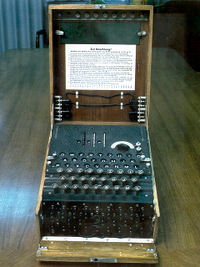
Weapons and technology improved rapidly during World War II and played a crucial role in determining the outcome of the war. Many major technologies were used for the first time, including nuclear weapons, radar, proximity fuzes, jet engines, ballistic missiles, and data-processing analog devices (primitive computers). Every year, the piston engines were improved. Enormous advances were made in aircraft, submarine, and tank designs, such that models coming into use at the beginning of the war were long obsolete by its end. One entirely new kind of ship was the amphibious landing craft.
Industrial production
Industrial production played a role in the Allied victory. The Allies more effectively mobilized their economies and drew from a larger economic base. The peak year of munitions production was 1944, with the Allies out-producing the Axis by a ratio of 3 to 1. (Germany produced 19% and Japan 7% of the world's munitions; the U.S. produced 47%, Britain and Canada 14%, and the Soviets 11%).
The Allies used low-cost mass production techniques, using standardized models. Japan and Germany continued to rely on expensive hand-crafted methods. Japan thus produced hundreds of airplane designs and did not reach mass-production efficiency; the new models were only slightly better than the original 1940 planes, while the Allies rapidly advanced in technology. Germany thus spent heavily on high-tech weaponry, including the V-1 flying bomb and V-2 rocket, advanced submarines, jet engines, and heavy tanks that proved strategically of minor value. "The Allies did not depend on simple numbers for victory but on the quality of their technology and the fighting effectiveness of their forces... In both Germany and Japan less emphasis was placed upon the non-combat areas of war: procurement, logistics, military services," concludes historian Richard Overy.
Delivery of weapons to the battlefront was a matter of logistics. The Allies again did a much better job in moving munitions from factories to the front lines. A large fraction of the German tanks after June 1944 never reached the battlefield, and those that did often ran short of fuel. Japan in particular was notably inefficient in its logistics system.
Medicine
Many new medical and surgical techniques were employed as well as new drugs like sulfa and penicillin, not to mention serious advances in biological warfare and nerve gases. The Japanese control of the quinine supply forced the Australians to invent new anti-malarial drugs. The saline bath was invented to treat burns. More prompt application of sulfa drugs saved countless lives. New local anesthetics were introduced making possible surgery close to the front lines. The Americans discovered that only 20% of wounds were cause by machine-gun or rifle bullets (compared to 35% in World War I). Most came from high explosive shells and fragments, which besides the direct wound caused shock from their blast effects. Most deaths came from shock and blood loss, which were countered by a major innovation, blood transfusions.
The massive research and development demands of the war accelerated the growth of the scientific communities in Allied states, while German and Japanese laboratories were disbanded; many German engineers and scientists continued their weapons research after the war in the United States and the Soviet Union.
Aftermath
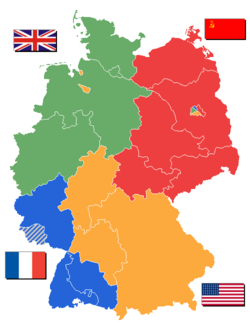
The war concluded with the surrender and occupation of Germany, Japan and Korea and recognition of the territory of Finland occupied by the Soviets. It left behind millions of displaced persons, prisoners of war, and resulted in many new international boundaries. The economies of Europe, China and Japan were largely destroyed as a result of the war.
To minimize the future possibilities of the destruction and death caused by war and conflicts, the allied nations, led by the United States of America, formed the United Nations in San Francisco, California in 1945 with the hope of preventing (or at least minimizing) further conflicts.
The end of the war brought the breakup of global empires of Britain, France and Holland and the formation of new nations and alliances throughout Asia and Africa. The Philippines were granted their independence in 1946 as previously promised by the United States. Germany's and Poland's boundaries were re-drawn and Germany was split into four zones of occupation in which the three zones under the Western Allies was reconstituted as a constitutional Democracy. The empire controlled by the Soviet Union increased as they took control over most of eastern Europe as well as incorporating parts of Finland and Poland into their new boundaries. Europe was informally split into Western and Soviet spheres of influence by Soviet distrust of anything not under their control, which heightened already existing tensions between the two camps and helped form the conflict known as the Cold War.
In Asia, the Imperial Japanese Empire's government was dismantled under General Douglas MacArthur and replaced by a constitutional monarchy with the emperor as a figurehead. The defeat of Japan led to the independence of Korea which was split into two parts by the Russian and American forces, marked the continuation of China's civil war and the eventual creation of the Communist People's Republic of China (PRC) on the mainland (1949) and the Nationalist Chinese (KMT) retreating to Taiwan.
World War II spawned many new technologies such as advanced aircraft, radar, jet engines, synthetic rubber and plastics, antibiotics like penicillin, helicopters, nuclear energy, rocket technology and computers. These technologies were applied to government, commercial, industrial, private and civil use.
Occupation of Axis Powers
Germany was partitioned into four zones of occupation, coordinated by the Allied Control Council. The American, British, and French zones joined in 1949 as the Federal Republic of Germany, and the Soviet zone became the German Democratic Republic. In Germany, economic suppression and Denazification took place. Millions of Germans and Poles were expelled from their homelands as a result of the territorial annexations in Eastern Europe agreed upon at the Yalta and Potsdam conferences. In the West, Alsace-Lorraine was returned to France, which also separated the Saar area from Germany.
Austria was separated from Germany and divided into four zones of occupation, which were reunited in 1955 to become the Republic of Austria.
Japan was occupied by the U.S, aided by Commonwealth troops, until the peace treaty took effect in 1952. In accordance with the Yalta Conference agreements, the Soviet Union occupied and subsequently annexed Sakhalin. Korea was divided between the U.S. and the Soviet Union, leading to the creation of two separate governments in 1948.
Europe in ruins
At the end of the war, millions of refugees were homeless, the European economy had collapsed, and 70% of the European industrial infrastructure was destroyed. The Soviet Union had been heavily affected, with 30% of its economy destroyed.
The United Kingdom ended the war economically exhausted by the war effort. The wartime coalition government was dissolved; new elections were held; and Churchill was defeated in a landslide general election by the Labour Party under Clement Attlee.
In 1947, U.S. Secretary of State George Marshall devised the "European Recovery Program", better known as the Marshall Plan. Effective during the years 1948 - 1952, it allocated 13 billion dollars for the reconstruction of Western Europe.
Communist control of Central and Eastern Europe
At the end of the war, the Soviet Union occupied much of Central and Eastern Europe and of the Balkans. In all the USSR-occupied countries, with the exception of Austria, the Soviet Union helped Communist regimes to power. Furthermore, it annexed the Baltic countries Estonia, Latvia, and Lithuania.
China
After China's victory against Japan in 1945, the truce between the U.S.-backed Kuomintang and the Soviet Union-backed Communists soon broke down and the Chinese Civil War resumed. The victorious Communists declared the People's Republic of China in 1949. The Kuomintang government fled to Taiwan.
Decolonization
The areas previously occupied by the colonial powers gained their freedom, some peacefully such as the Philippines in 1946, India and Pakistan in 1947. Others had to fight bloody wars of liberation before gaining freedom, such as against the French attempt to reoccupy Vietnam in the First Indochina War, and against the Netherlands' attempt to reoccupy the Dutch East Indies.
United Nations
Because the League of Nations had failed to actively prevent the war, the United Nations was created in 1945. The UN operates within the parameters of the United Nations Charter, and the reason for the UN’s formation is outlined in the Preamble to the United Nations Charter. One of the first actions of the United Nations was the creation of the State of Israel, partly in response to the Holocaust.
Names
The term most used in the United Kingdom and Canada is "Second World War", while American publishers use the term "World War II". Thus the Oxford University Press uses The Oxford Companion to the Second World War in the United Kingdom, and The Oxford Companion to World War II for the identical 1995 book in the United States.
The OED reports the first use of "Second World War" was by novelist H.G. Wells in 1930, although it may well have been used earlier. The term was immediately used when war was declared; for example, the September 3, 1939, issue of the Canadian newspaper, The Calgary Herald.


